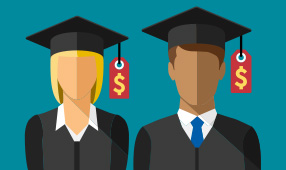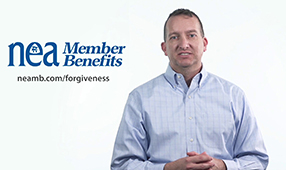Like many educators, you may have needed a loan (or two) to get your degree. Fortunately, there are ways to find relief from your student loan debt once you’re out of school. This relief can come from income-based repayment options and forgiveness programs, but you have to know and follow the rules to the letter to make sure you take advantage of the programs.
There has been considerable fluctuation in student loan forgiveness policies as the Biden Administration weighs various possibilities. The U.S. Supreme Court ruled on June 30, 2023, that the president needs congressional authorization to make a sweeping cancellation of student debt, which put an end to the Covid-19 suspension of debt service and required payments to resume 60 days later and the situation remains fluid. In the meantime, here are four things you need to know to make the most of your student loan debt reduction and forgiveness options as an educator.
1. Some or all of your debt could be forgiven, if you meet certain requirements.
There are several programs associated with federal student loan forgiveness. Public Service Loan Forgiveness (PSLF) is one of the best-known programs for educators. It forgives any balance remaining on your William D. Ford Federal Direct Loan after you make 120 qualifying monthly payments—equal to 10 years’ worth—while working for a qualifying public service employer.
Not sure what kind of federal student loan you have? To find out, you can review your loan documentation to confirm your loan type, or you can log in to My Federal Student Aid with your FSA ID to see the information stored in the National Student Loan Data System (NSLDS®) database.
Most full-time public and private elementary and secondary school teachers meet the employment requirements, according to the U.S. Department of Education.
In order for your payments to qualify and count toward the 120 monthly payments required to be eligible for PSLF, each one needs to be paid in full no more than 15 days late and made after Oct. 1, 2007.
If you didn’t borrow through a Ford Direct Loan, you could still make yourself eligible for PSLF by combining your loans into a Direct Consolidation Loan.
The Teacher Loan Forgiveness program enables certain “highly qualified” teachers in low-income Title 1 schools to be eligible for $5,000 – or even $17,500 depending on what you teach – in forgiven debt after teaching for five consecutive years.
“Highly qualified” means you’ve earned a bachelor’s degree, received a full state teaching certification, and have not had your certification or licensure requirements waived on an emergency, temporary or provisional basis.
If you teach math or science in a secondary school, or special education at the elementary or secondary school level, you may be eligible to receive $17,500 in forgiveness. Even if you don’t, you could still receive $5,000 in loan forgiveness if you’re considered a highly qualified full-time elementary or secondary education teacher.
You can qualify for forgiveness under both the Teacher Loan Forgiveness Program and the Public Service Loan Forgiveness Program, but you can’t count the same period of teaching service for both. That means any payments you made on a Direct Loan during the five-year period of the Teacher Loan Forgiveness Program cannot count toward your 120 monthly payments for PSLF.
Perkins Loan Teacher Cancellation offers up to 100% forgiveness for Federal Perkins Loans if you teach at a low-income school. You also may qualify if you teach mathematics, science, a foreign language, bilingual or special education, or a subject in which your state education agency has determined to have a shortage of teachers.
2. Private refinancing or consolidating could negatively impact your forgiveness or repayment options.
It’s important to research and fully understand the implications of any change you want to make to your student loans.
Yes, refinancing may offer better payment terms. You may, for example, find that you could switch from your fixed loan (that always charges the same amount of interest) to a variable-rate private loan and receive an initial, short-term reduction in the monthly interest you’d pay. However, you could miss out on forgiveness opportunities in the process because your federal loans would be converted to private loans.
“Forgiveness programs are limited to federal student loans,” says Mark Kantrowitz, publisher of PrivateStudentLoans.guru and recognized expert on student loans. “If you refinance a federal student loan into a private student loan, you will lose the loan forgiveness.”
What’s more, federal student loans carry fixed-interest rates, so although the initial, lower interest rate of a private, variable loan may look tempting, it could soar after the rate expires. That won’t happen with a fixed, federal loan.
You could also pay more in interest because the new loan would take longer to pay off. Some educators may consolidate older FFEL (Federal Family Education Loan) debt into a direct loan in order to become eligible for Public Service Loan Forgiveness.
You can also consolidate your federal loans into a Direct Consolidation Loan for free through the Department of Education and its loan servicers. Learn about the many pros and cons of federal loan consolidation here.
3. Grace periods offer time to get your financial house in order.
Upon graduation, federal loans offer six months of deferral before payments start. Perkins Loans allow for nine months. You can use this “grace period” time wisely by tending to other financial needs. Use the time to create an emergency fund of three to six months’ worth of living expenses, which may require you to create a budget so that you know how much you need.
4. As an NEA member, you have complimentary access to a tool to explore your repayment and forgiveness options.
The NEA Student Debt Navigator, helps you quickly and easily assess whether you qualify for free federal forgiveness programs. On average, the tens of thousands of NEA members who have used this benefit are seeing more than $2,000 a year in new savings through this tool and an average of about $28,000 in potential student loan debt forgiveness.
Input information about yourself and your loans, such as your income, the amount of your monthly student loan payments, how long you’ve been teaching and where, and subject(s) taught. The Savi tool analyzes your information and displays available repayment and forgiveness options.
If you want to apply for Teacher Loan Forgiveness or Perkins Loan Teacher Cancellation, for example, it automatically determines whether your school qualifies as Title 1 (a low-income school).
There is no cost for NEA members to use the Savi interactive calculator to determine eligibility and potential savings.
If you want the convenience of filing electronically through the platform or want to talk to a student loan expert, you can do so for free for the first year, thanks to our Members Insurance Trust. This can help speed up your application process, and a reduction in potential form errors can increase the likelihood of forgiveness approval.
Find out more here about how the NEA Student Debt Navigator tool works to analyze your loans and find all the repayment and forgiveness options available to you.









